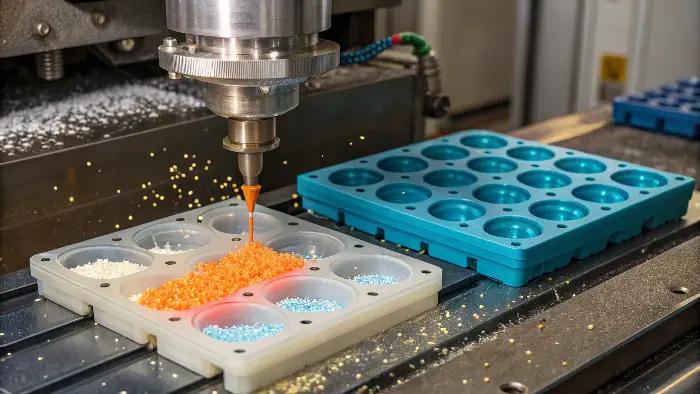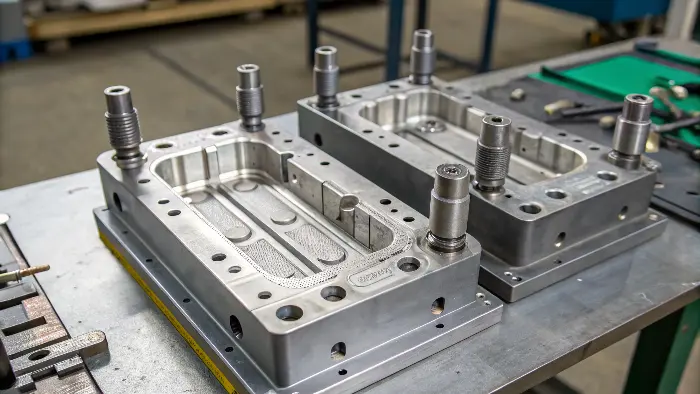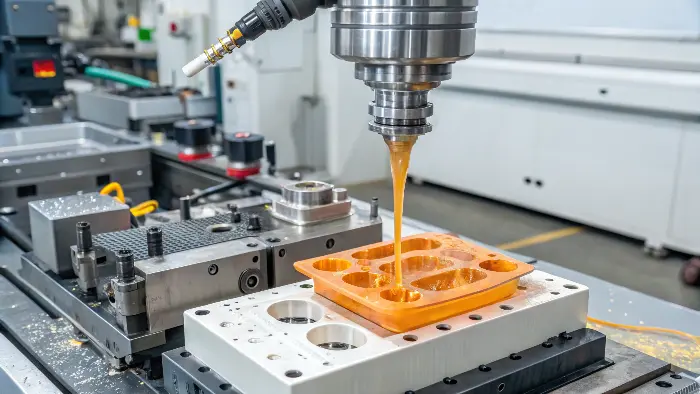Ever wondered how car parts, from dashboards to bumpers, achieve such complex shapes and consistent quality while being mass-produced? It’s a big puzzle, especially with rising cost pressures and demands for lighter, more fuel-efficient vehicles.
Automotive injection molding is the key. It’s a high-volume manufacturing process that creates intricate, durable, and lightweight plastic components for vehicle interiors and exteriors by injecting molten plastic into precisely engineered molds. This method delivers quality, consistency, and design freedom.
It’s pretty amazing stuff, isn’t it? When you hop into your car, almost everything you touch and see that isn’t metal or fabric has likely been born from an injection mold. As someone who’s spent years in the mold industry, from my early days on the factory floor to now running CKMOLD and helping businesses like Michael’s thrive, I’ve seen this technology work wonders. The automotive sector, in particular, relies heavily on it. They need parts that are strong, look good, fit perfectly, and can be made in the millions without breaking the bank. Let’s take a closer look at how this all comes together.
So, What Exactly is Automotive Injection Molding Anyway?
You hear "injection molding" thrown around, but what does it really mean when we’re talking about cars? Confused about how this one process can create so many different automotive parts, from tiny clips to massive bumpers? It’s all about versatility and precision.
Automotive injection molding is a specialized manufacturing process used to produce a vast array of plastic components for vehicles. It involves injecting molten thermoplastic or thermosetting polymers into a custom-designed mold cavity under high pressure, allowing for complex, high-precision parts to be made rapidly and consistently.
| Think about it – the automotive industry is a beast! They demand incredible precision, super high quality, and parts that can withstand everything from scorching summer heat to freezing winter cold, not to mention constant vibration and, sometimes, impacts. Automotive injection molding is the workhorse that makes so much of this possible. It’s not just about squirting plastic into a shape; it’s a highly engineered system. We’re talking about parts like intricate dashboard assemblies, interior door panels with integrated speaker grilles and armrests, tough exterior bumpers, aerodynamic trim pieces, light housings, and even critical under-the-hood components like engine covers or fluid reservoirs. I remember when I first started, I was amazed at the sheer variety. One day we’d be working on a mold for delicate interior switchgear, the next for a robust fender liner. The core principle is the same, but the specifics – the type of plastic, the complexity of the mold, the tolerances required – vary massively. For a business owner like Michael, who’s focused on efficiency and product quality, understanding that this process can deliver such diverse components with repeatable accuracy is a big deal. It means car manufacturers can design vehicles with more intricate features, better aesthetics, and improved safety, all while keeping an eye on production costs and weight reduction (which is huge for fuel efficiency!). It’s really the backbone of modern car component manufacturing. We at CKMOLD have helped many clients navigate the specifics of their automotive projects, ensuring the molds we design and the parts produced meet these stringent industry standards. It’s a fascinating field, always pushing the boundaries of what’s possible with plastics. |
Aspect | Automotive Injection Molding Application | Benefit for Car Manufacturers & Consumers |
|---|---|---|---|
| Interior Parts | Dashboards, door panels, center consoles, trim, seat components, HVAC vents | Enhanced aesthetics, ergonomic designs, integrated features, noise reduction | |
| Exterior Parts | Bumpers, grilles, spoilers, mirror housings, fender flares, light housings | Aerodynamic efficiency, impact resistance, weight reduction, styling freedom | |
| Under-the-Hood | Engine covers, air intake manifolds, battery trays, fluid reservoirs | Heat resistance, chemical resistance, lightweighting, complex geometries | |
| Safety Features | Airbag housings, seatbelt components, interior pillar covers | Strength, impact absorption, consistent performance |
What are the Absolute Basics You Need to Know About Injection Molding?
The term "injection molding" might sound technical and a bit daunting. Worried it’s too complex to grasp, especially if you’re trying to understand how your automotive components are made? Don’t be! The fundamental concept is actually quite straightforward.
The basics of injection molding involve melting plastic pellets, injecting this molten plastic under high pressure into a precisely machined mold cavity, allowing the plastic to cool and solidify into the desired shape, and then ejecting the finished part. It’s a cyclical process, super efficient for mass production.

Okay, let’s break it down – no fancy engineering degrees needed here, I promise! Imagine you have a very, very strong and precisely shaped metal mold. This mold has a cavity in it, which is the exact reverse shape of the part you want to make, say, a car door handle or a button for the dashboard.
First, we take tiny plastic pellets – think of them like raw ingredients – and feed them into a hopper on the injection molding machine. These pellets are then conveyed by a large screw through a heated barrel. As the screw rotates and moves forward, it does two things: it melts the plastic pellets into a hot, molten liquid (like thick honey), and it builds up pressure.
Once we have enough molten plastic ready, the screw rams forward, kind of like a plunger in a syringe, and injects this molten plastic at very high pressure into that closed mold cavity. It has to fill every nook and cranny of the mold perfectly.
Then, the plastic is held under pressure in the mold while it cools down and solidifies, taking the shape of the cavity. Cooling is often helped by channels running through the mold with circulating water or oil.
Finally, once the part is solid, the mold opens up, and an ejector system (usually pins) pushes the finished plastic part out. The mold then closes again, and the whole cycle repeats – melt, inject, cool, eject. And it can happen really fast, sometimes in just a few seconds for small parts!
I’ve seen this cycle countless times, from my early days watching the machines run to now discussing cycle times and efficiency with clients like Michael. The beauty of it, especially for automotive where you need millions of identical parts, is that once you get the mold and the process parameters (like temperature, pressure, and cooling time) just right, you can produce parts with incredible consistency and speed. That’s the core of it! It’s this simple yet powerful cycle that creates so many of the plastic components that make up our cars.
What Goes Into Making the Actual Plastic Injection Mold Itself?
| So we know plastic gets injected into a mold, but what is this "mold" thing really made of? It sounds simple, but the mold is where the real magic and a lot of the upfront work happens, especially for complex automotive parts. A plastic injection mold is a highly engineered tool, typically made from hardened steel, consisting of two main halves (A-side and B-side). Key components include the cavity (shapes the part’s exterior), core (shapes the interior), sprue, runners, gates (direct plastic flow), cooling channels, and an ejection system.  Oh boy, the mold! That’s where so much of my passion lies, and it’s truly the heart of the injection molding process. When I first got into this business, I was fascinated by the precision and complexity of these tools. They’re not just simple blocks of metal; they are intricate pieces of engineering that can cost a fair bit and take weeks, sometimes months, to design and build. For automotive parts, which often have complex geometries, tight tolerances, and need to produce millions of units, the mold has to be top-notch. Let’s break it down a bit. You’ve got the mold base, which is like the foundation holding everything together. Then, the most critical parts are the cavity and the core. The cavity, usually on the "A-side" or stationary half of the mold, forms the external surfaces of the plastic part. The core, on the "B-side" or moving half, forms the internal surfaces. When these two halves clamp together in the molding machine, the space between the cavity and core creates the shape of the part. Then you need a way to get the molten plastic in. That’s where the sprue bushing, runners, and gates come in. The sprue is where the machine’s nozzle connects to the mold. Runners are channels machined into the mold face that distribute the molten plastic from the sprue to the gates, which are small openings that lead directly into the cavity. The design of these is critical for ensuring the plastic fills the mold evenly and without defects. Cooling channels are also super important. They circulate water or oil through the mold to control the temperature and help the plastic solidify quickly and uniformly. If cooling isn’t right, you can get warped parts or long cycle times. And finally, once the part is solid, you need to get it out! That’s the job of the ejection system, which usually involves ejector pins, sleeves, or plates that push the part out of the mold cavity when the mold opens. For complex automotive parts with undercuts or internal threads, molds can also have slides and lifters – moving components within the mold that create these features and then retract before ejection. Designing and building these molds, especially for a client like Michael who expects reliability and precision for his automotive components, is a real craft. It requires skilled designers, toolmakers, and high-precision machinery. At CKMOLD, we’ve spent years perfecting this, because we know a good part starts with a great mold. |
Mold Component | Function | Importance for Automotive Parts |
|---|---|---|---|
| Mold Base | Foundation holding all components securely | Provides stability for high-pressure injection cycles | |
| Cavity (A-Side) | Forms the external shape of the plastic part | Defines aesthetics, fit, and finish of components like dashboards | |
| Core (B-Side) | Forms the internal shape of the plastic part | Creates internal features, mounting bosses, ribbing for strength | |
| Sprue/Runners/Gates | Channel molten plastic from machine nozzle to the cavity | Ensures proper fill, minimizes defects, affects cycle time | |
| Cooling System | Regulates mold temperature for solidification | Critical for dimensional stability, preventing warpage, cycle time | |
| Ejection System | Pushes the solidified part out of the mold | Ensures clean part removal without damage, allows automation | |
| Slides/Lifters | Create undercuts or complex internal/external features | Enables complex designs like snap-fits or integrated clips |
Are There Any "Rules of Thumb" for Getting Automotive Injection Molding Right?
Okay, so we know what it is and how it works. But what are the unwritten rules or key principles for really nailing automotive injection molding projects? You want reliable, high-quality parts without endless headaches, right? It’s about smart design and process control.
Key "rules of thumb" for successful automotive injection molding include: maintaining uniform wall thickness to prevent sink marks and warping, incorporating draft angles for easy part ejection, designing generous radii on corners to reduce stress, selecting the right material for the application’s demands (e.g., UV resistance, impact strength), and considering the gate location carefully.

Ah, the "rules of thumb" – I like to think of these more as hard-won lessons from years in the trenches! When you’re dealing with automotive components, the stakes are high. A failing part can mean recalls, safety issues, or just a really bad customer experience. So, getting it right from the design stage is absolutely crucial. This is what we call Design for Manufacturability (DFM), and it’s something I always stress with clients, especially those like Michael who are deeply involved in their production.
One of the biggest ones is uniform wall thickness. If you have a part with a really thick section next to a thin section, the thick section will cool and shrink slower, potentially causing sink marks (depressions on the surface) or warpage. Keeping wall thickness as consistent as possible is a golden rule. If you need extra strength, use ribs instead of just making a whole section thicker.
Then there’s draft angle. Imagine trying to pull a perfectly straight-sided cup out of a tight-fitting Jell-O mold – it’s tough! Draft angle means adding a slight taper (usually 1-3 degrees) to the walls of the part perpendicular to the mold opening direction. This makes it way easier for the part to release from the mold, reducing scuffing and stress on the ejector pins. It’s a small detail that makes a huge difference in production.
Radii on corners are another biggie. Sharp internal corners are stress concentrators, making the part weaker. Generous, rounded corners distribute stress better and also help the plastic flow more smoothly in the mold.
Material selection is, of course, paramount, as we’ve touched on. For automotive, you’re looking at factors like UV stability for exterior parts, temperature resistance for under-hood components, impact strength for bumpers, and chemical resistance. Using the wrong plastic is a recipe for disaster.
And gate location! Where the plastic enters the cavity can affect how the part fills, where weld lines (where two flow fronts meet) appear, and even the part’s final dimensions and strength. We use mold flow simulation software to predict this and optimize gate locations.
These aren’t just arbitrary rules; they are based on the physics of how plastic behaves when it’s molten, injected, and cooled. Ignoring them usually leads to production problems, higher reject rates, and increased costs down the line. I’ve seen it happen! Investing a bit more time upfront in good DFM, working with experienced mold designers – that’s the smart way to approach automotive injection molding. It saves so much pain later on.
Conclusion
Automotive injection molding is clearly the engine driving the creation of countless car components, inside and out. It offers precision, design flexibility, material variety, and the scalability vital for this massive industry. CKMOLD is dedicated to helping you understand and leverage this powerful technology.
